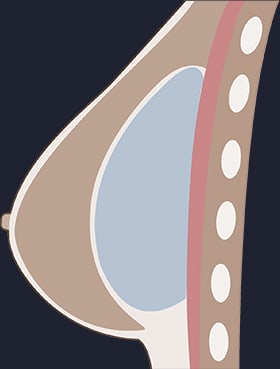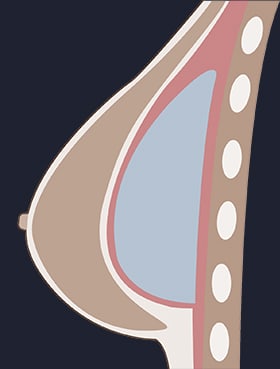Breast Augmentation
Home|Breast Surgery|Breast Augmentation
Quick Facts About Breast Augmentation
- Principle Benefits: Enhances breast size and shape for improved body proportions, boosts self-confidence, and restores volume lost due to aging, weight loss, or pregnancy.
- Treatment Details: A surgical procedure that involves placing implants (saline or silicone) behind the breast tissue or muscle. The most common Incision options employed by Dr. Lintner include the inframammary (under the breast) and periareolar (around the nipple) techniques. Procedure typically lasts 1-2 hours under general anesthesia.
- Recovery Timeline: Initial recovery is 1-2 weeks, with most patients resuming normal activities within 4-6 weeks. Full results are visible after 2-3 months as swelling subsides.
- Cost: According to statistics from the American Society of Plastic Surgeons, the average cost of a breast augmentation is $4,875. That said, this estimate may not include additional fees associated with hospital facilities, anesthesia, and postoperative medications. A personalized quote can be provided following a consultation.
Advanced Aesthetic Surgery offers residents of the Atlanta and Marietta area world-class breast augmentation (breast enlargement) performed by a compassionate doctor. Board-certified plastic surgeon Thomas Lintner, MD does not employ a “bigger is better” approach to breast augmentation. He wants his patients to have breast implants that fit their body. As a caring surgeon, Dr. Lintner bases his breast enlargement recommendations on an individual’s needs and on achieving a natural look.
When planning for breast augmentation surgery, patients must consider placement and size of their breast implants. Dr. Lintner will review the advantages of placing saline or silicone breast implants under the muscle instead of over the muscle. He also wants patients to be aware of the possible incision locations when deciding on breast enlargement.
Many patients are concerned about complications and recovery time for breast enlargement. Aware of these concerns, Dr. Lintner reviews possible complications with all of his breast augmentation patients prior to surgery. If appropriate, Dr. Lintner can also discuss the possibility of combining your breast surgery with a tummy tuck or liposuction.
There is much information to consider following the decision to pursue breast augmentation and Dr. Lintner will be there to guide you through every step of surgery. We encourage you to read through the information below to gain an understanding of what the breast augmentation process entails, and invite you to contact our practice if you have any questions or wish to schedule a consultation.
What is Breast Augmentation?
Breast augmentation is designed to enhance the proportions of the breasts in relation to your unique figure with the use of saline or silicone implants. As one of the most popular cosmetic surgeries in the country, breast augmentation is capable of achieving a spectrum of aesthetic goals related to enlarged breast size, enhanced contours, or a more symmetrical breast appearance—offering results that can appear exceptionally natural. Many women undergo breast augmentation to fulfill long-held desires for breast enhancement, while a large portion of patients also pursue the procedure to restore breast volume lost after pregnancy and breastfeeding. In any case, breast augmentation can offer eligible candidates increased breast volume, as well as improved shape and symmetry, for many years—even decades—to come.

Do I Need a Breast Augmentation and Lift?
Ideal breast augmentation candidates should have good skin quality, but individuals who exhibit some skin laxity may benefit from combining a breast lift with their procedure. A breast lift is performed to address breasts that have descended from their natural positioning as a result of gravity, pregnancy, breastfeeding, or the natural aging process. While a breast augmentation alone cannot substantially improve the look of breast sag, a comprehensive breast lift with implants procedure can be a highly effective technique to raise and reshape the breasts, making them appear more youthful and projected, in addition to achieving volume enhancement. If you exhibit lax breast skin, or you simply desire more extensive rejuvenation than a breast augmentation can provide, a breast augmentation with a lift may be able to address your concerns more fully. Dr. Lintner can suggest the best treatment options for your unique needs and goals during a consultation.
What Are My Breast Implant Options?
Women are now able to choose silicone breast implants for breast augmentation. Approved by the FDA in November 2006, silicone breast implants create soft, natural looking enhancements.
In January 2011, the FDA released an advisory statement for women with breast implants. The FDA has not changed the status or availability of breast implants and has reaffirmed that the devices are safe and effective. Please click here for more information. We will continue to follow this story and provide more information as it comes to light.
FDA data shows no correlation between silicone breast implants and disease. Potential long-term complications include leakage and the hardening of the implant pocket; however, these conditions are rare. Dr. Thomas Lintner places such a premium on patient safety that long after his patients are healed and back to normal, he continues to see his patients annually, free of charge until he retires, for a thorough examination. If any problems are found during these free follow-up visits, they can be diagnosed and treated quickly.


Breast Implant Placement
Breast implants are placed either under the muscle, which is the most common approach, or over the muscle. Depending on your unique body proportions, Dr. Lintner can recommend the best possible placement for your implants.
Placing the implant under the muscle has several advantages:
- The breasts will not sag as much over time (i.e. they will not age as quickly when compared to an over-the-muscle technique).
- The breasts will not harden as much over time and there is a lower rate of capsular contracture.
- The breasts are less likely to have an unnatural “coconut-shaped” look.
- Mammograms are more effectively performed.
The only disadvantages to placing an implant under the muscle are that the technique can require a relatively longer recovery period, and there may be some pulling in of the breast skin when working the pectoralis (chest) muscles. Ultimately, the advantages frequently outweigh the disadvantages. In most cases, Dr. Lintner prefers to place breast implants under the muscle, but certain individuals may benefit from subglandular (above the muscle) placement.
What is Breast Augmentation Recovery Like?
After surgery, patients will need a family member or friend to drive them home. Dr. Lintner encourages patients to rest for about an hour after they arrive home, but recommends getting up and moving around shortly thereafter. Driving can be resumed once patients have ceased use of pain medications for at least 24 hours. Individuals should avoid strenuous activity for approximately six to eight weeks after surgery. Most patients are able to return to work and their daily activities after about two weeks of recovery. Light exercise may be resumed after four weeks; however, weights and more vigorous exercises should be avoided for six weeks or longer, depending on what type of activity you are doing. When resuming more difficult activities, Dr. Lintner encourages patients to take it easy and ease back into your routine.
Patients often feel tired and sore for a few days after surgery, and will experience a bit of tightness in their chest area. Any mild discomfort can usually be alleviated with medication. Dr. Lintner will provide customized aftercare instructions for each of his patients – adhering to his advice can help ensure you achieve the best possible results and minimize any chance of complications.
Dr. Lintner will conduct follow-up appointments for breast augmentation patients at one week, six weeks, three months, six months, and one year. He also encourages patients to continue to return each year for a complimentary check-up appointment, ensuring any potential issues can be found and addressed as soon as possible. In the extremely rare event that a patient no longer desires her implants, Dr. Lintner will remove them for a materials fee only. However, he recommends that patients live with their implants for a while to try to become comfortable with the change.
Will I Have Breast Augmentation Scars?
Scars from breast augmentation generally mirror the incision technique used to place the implants. Depending on your specific treatment plan, scars may appear at the borders of the areola, along the inframammary fold, or within a fold of the underarm. When the procedure is performed by a qualified and experienced plastic surgeon, incisions can be made very discreetly for minimized post-surgical scarring. Dr. Lintner takes great care to place incisions in the natural creases and contours of the breasts whenever possible for an exceptionally natural-looking result. Furthermore, following Dr. Lintner’s instructions on proper wound care can increase the likelihood of breast augmentation scars fading over time.
How Much Does Breast Augmentation Cost?
According to 2024 statistics from the American Society of Plastic Surgeons, the average cost of breast augmentation is approximately $4,875. That said, due to the customizable nature of the procedure, breast augmentation cost can vary from patient to patient. The total price depends on the type of implants selected, surgeon’s fee, anesthesia, hospital/facility fee, medications, compression garments, and more. To help make the cost more manageable, we offer plastic surgery financing through Parasail and Prosper Healthcare lending. A surgeon’s skill and experience are usually factored into the price, as well, so any surgery that is heavily discounted is probably best to avoid.
Additional Breast Augmentation FAQs
-
Am I a candidate for breast augmentation?
Most adult women in good health can be considered candidates for breast augmentation. While there is no upper age limit for the procedure, patients seeking silicone breast implants must be at least 21 years old. Saline breast implants can be placed in patients who are 18 years of age or older. Exceptions can usually be made for breast cancer patients under these age requirements who plan to undergo breast reconstruction.
You will be able to discuss your goals and expectations during your one-on-one consultation with Dr. Lintner, and he will make recommendations for the approach that he believes can best meet your unique needs.
-
How do I choose the right shape and size for my breast implants?
To select the right type of breast implants, many factors must be taken into consideration, including your body type and individual aesthetic goals. There is no “one size fits all” approach when it comes to breast implants—what looks good on one person may not look good on another. In your consultation, Dr. Lintner can conduct a thorough examination to help you determine the best possible options to achieve your desired look.
-
Is there an age limit for breast implants?
Although some patients may be concerned about being “too old” for breast implants, there is actually no upper age limit for breast augmentation candidates. As long as a patient is in good health, they can usually be considered a candidate.
-
Can I breastfeed with breast implants?
Women who were able to breastfeed prior to breast augmentation should still be able to breastfeed after surgery. Unfortunately, if a woman elects to have breast augmentation surgery prior to having children, she may be unaware of whether or not she was ever able to breastfeed initially. Dr. Lintner takes great care to utilize a surgical technique that protects the integrity of the milk ducts, helping to ensure the ability to breastfeed is not affected by surgery.
-
How should I sleep after breast augmentation?
To best support the healing and recovery process, Dr. Lintner recommends sleeping on your back at a slight elevation for the first few weeks after your breast augmentation. This can typically be achieved using pillows to prop yourself up or by sleeping in a recliner. Sleeping in this manner can help to ensure no pressure is placed on your new implants while also avoiding impact to the incisions and encouraging healthy circulation.
-
How do I reduce swelling after breast augmentation?
Swelling is a common part of the healing process after breast augmentation. It should gradually fade over the first six weeks of recovery, with some residual swelling lasting up to six months. Using over-the-counter pain medication as directed by your doctor along with intermittent cold compresses can typically help to ease any discomfort associated with post-surgical swelling. Additionally, getting plenty of rest, staying hydrated, and eating a nutritious, anti-inflammatory diet are all excellent ways to help reduce swelling and promote healing.
-
When can I drive after breast augmentation?
Patients should not resume driving until at least 24 hours after they have stopped taking any prescription pain medications. Beyond that restriction, the decision as to when it is appropriate to get back behind the wheel is largely a matter of personal comfort. In general, most patients begin driving again after about one to two weeks.
-
How long after breast augmentation can I swim?
In general, Dr. Lintner advises waiting at least 3-4 weeks before swimming after your procedure. Breast augmentation incisions should be kept clean and dry after surgery, since the skin’s natural water-resistance is often compromised during the healing phase. During your post-operative visits, your doctor can assess the progress of your recovery and provide personalized recommendations regarding when swimming can be safely resumed.
-
What kind of bra should I wear after breast augmentation?
For the first few days following breast augmentation, patients typically wear a surgical bra with wide straps for enhanced support and clasps in the front for easier management. For the next few weeks, a compressive bra or tight-fitting sports bra is recommended to support your breast implants as they settle into position and protect your incisions while they heal. Bras with underwires should be avoided for at least six weeks, as they can irritate incisions placed in the inframammary fold and prevent the implants from settling properly. Once your breast implants have dropped into position and your incisions are appropriately healed, you may wear whatever bra makes you feel the most comfortable and confident—keeping in mind that selecting a supportive and well-fitting garment can be beneficial to your long-term spinal health, posture, and breast aesthetics.
-
Do I need to massage my breast implants?
Breast implant massage is often recommended by surgeons to help soften the breast tissue, promote implant mobility, and reduce the risk of capsular contracture (scar tissue formation). It typically begins 1-2 weeks after surgery, once initial healing has occurred. The technique involves gently moving the implants within the breast pocket using specific motions guided by your surgeon. Patients should perform the massage 2-3 times daily for several minutes, as advised. Always consult your surgeon before starting, as not all implants or surgical techniques require postoperative massage.
Contact Advanced Aesthetic Surgery
If you are interested in breast enlargement with breast implants, contact Advanced Aesthetic Surgery to schedule a consultation.